Ram From Hell
Full Access Member
Silverback said:Heat energy is different than HOT.
Okay Professor Primate, an object isn't hot, but rather dissipating the heat energy that it produced or had been transferred to it. If heat cannot do anything more than transfer to another object or substance, are you referring to the subsequent reaction of that object or substance to the act of that transference process (such as the rapid expansion of air in the combustion process)? Are you meaning that heat energy is the act of the conveyance of the heat from one substance or object to another?
So what is the definition of heat energy?
Definition: Heat energy (or just heat) is a form of energy which transfers among particles in a substance (or system) by means of kinetic energy of those particle. In other words, under kinetic theory, the heat is transfered by particles bouncing into each other.
Or perhaps it is thermal energy?
In thermal physics, thermal energy is the energy portion of a system that increases with its temperature. In a loose sense, "thermal energy" is a term often used to describe the energy content of a system related to heating effects, e.g. temperature increase or decrease. In thermodynamics, thermal energy is the internal energy present in a system in a state of thermodynamic equilibrium by virtue of its temperature.[1] The term is not widely used, however, in a rigorous sense, owing to the result that the phrase "thermal (heat) energy" is counter-intuitive. That is, heat can only be defined as any spontaneous flow of energy (energy in transit) from one object to another, caused by a difference in temperature between two objects; thus, an object cannot posses "heat".[2] This is explained by the second law of thermodynamics. Hence, by extrapolation, it is difficult to define quantities of heat energy (thermal energy). In isolated cases, however, a few definitions do exist.
Your turn.





